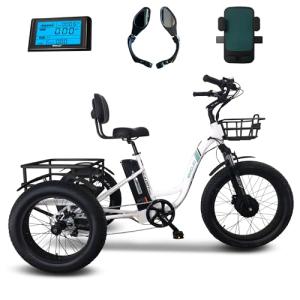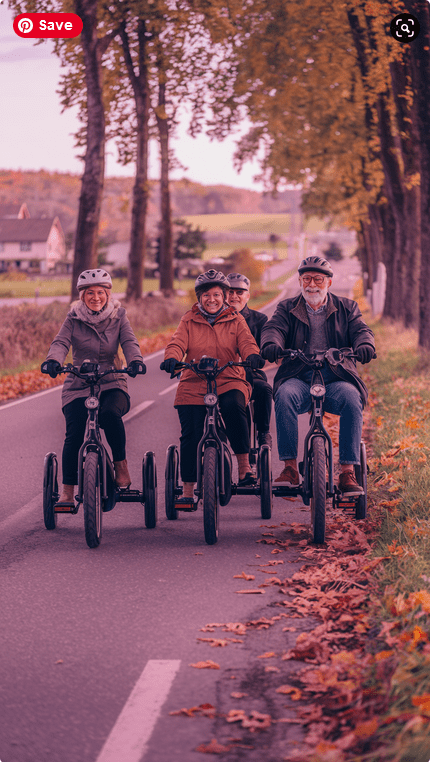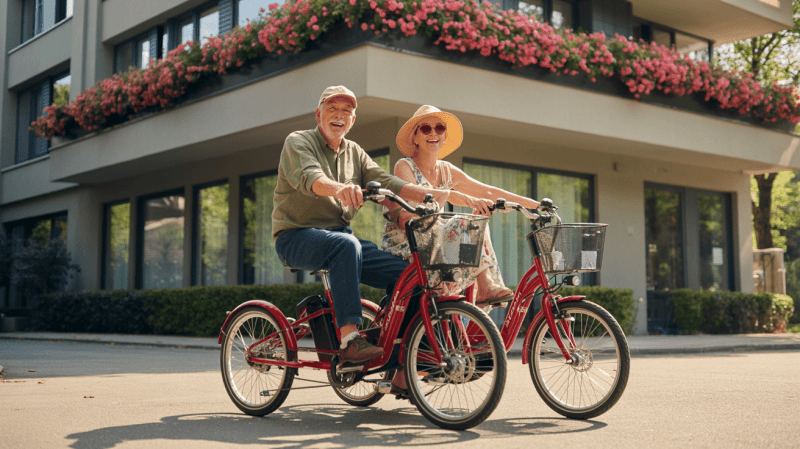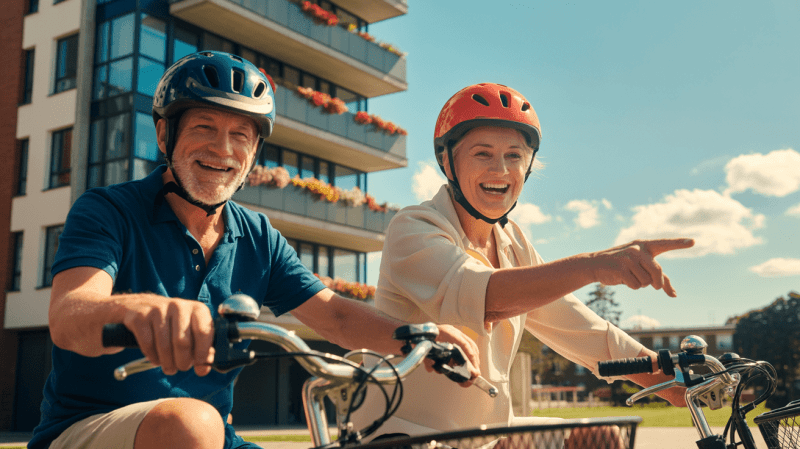"How To Overcome Fear And Get Back On The Bike As A Senior"
Hesitation to hop back on your bike in your golden years is a familiar feeling for many. Studies show that staying active can greatly benefit senior health, but fear of falling or injury often keeps bikes parked.
This article offers practical strategies and tips to regain confidence and conquer cycling fears, helping seniors enjoy the ride once more. Let's roll into a safer, joyful biking experience!
Key Takeaways
- Practice makes perfect. Start riding in a safe place and slowly build up your skills to gain confidence.
- Adjust your bike to fit you right. A well-fitted bike helps with balance and control, making it easier to ride.
- Use deep breathing to calm nerves before and during rides. This can help you relax and enjoy biking more.
- Look for e-bike discount programs that make getting an electric bike more affordable for seniors.
- Join cycling groups or attend workshops designed for senior riders. These resources offer learning and social support to help overcome fear of biking.
Challenges Faced by Seniors in Riding a Bike

For many seniors, the thought of cycling again stirs a mix of emotions—from nostalgic yearnings to palpable trepidation. It's not just the act of pedaling that presents a hurdle; it's the mental and physical barriers that form in life's later chapters, often turning a once pleasurable activity into an intimidating prospect.
Fear
It can be tough getting back on the bike after a scary fall or a long break. You might feel nervous or think it's too late to ride again. But fear doesn't have to keep you from enjoying your rides.
Building confidence takes time and patience, but you can conquer your cycling anxiety.
Start with small steps and celebrate every win along the way. Riding in a safe place like an empty parking lot helps shake off the nerves. Tell yourself, "I've got this," and believe in your ability to regain trust on two wheels.
Remember, each pedal stroke is progress toward fearless senior cycling!
Lack of Riding Experience
Starting to ride a bike again can feel like learning from scratch, especially if you haven't ridden in years. Don't worry – this is common among seniors. You might not remember how to balance or turn with confidence.
That's okay! The key is to take small steps and build up your skills over time.
Practice makes perfect. Find a quiet spot, like an empty parking lot or park path, where you can ride without stress. Begin with simple moves: riding in straight lines and then making gentle turns.
As you get more comfortable, you'll gain back your muscle memory and the confidence that comes with it. Before long, riding will become second nature once again, just as it was when you were younger.
Keep going at your own pace; there's no rush!

Physical Limitations
Lack of experience isn't the only hurdle – physical challenges can make hopping on a bike feel daunting. Some seniors worry about their balance or think their muscles aren't strong enough.
Aging bodies may have stiff joints, less flexibility, and slower reflexes. These are real concerns when thinking about cycling safety and enjoyment.
But here's the good news: bikes can be adapted to suit your needs! Consider seats that ease pressure on sore spots or handlebars shaped for better grip and comfort. Step-through frames make getting on and off easier, while electric bikes offer a helpful boost up hills.
Focus on what you can do and adjust where needed—you've got this!
Tips to Overcome Fear of Riding a Bike

Confronting the trepidation that comes with hopping back on a bike in your golden years can seem daunting, but it's not an impossible task. Equipped with the right mindset and strategies, you can rediscover the joys of cycling, turning fear into triumph as you pedal past your anxieties.
Get a tune-up
Check your bike before you ride. Take it to a local shop for a full tune-up. The mechanic will adjust the brakes, check the tires, and make sure everything is tight and right. This helps prevent accidents caused by equipment failure.
With a well-oiled machine, you'll feel safer and more confident on your next ride.
Regular maintenance keeps your bike in top shape and boosts your confidence. It's like having a trusted friend who's always ready to roll. Plus, learning about your bike can be fun! Ask questions while at the shop; knowledge builds confidence for senior cyclists conquering their fears of riding again.
Practice Handling Skills
After ensuring your bike is in good shape, it's time to focus on honing your handling skills. This will boost your confidence and help keep fear at bay. Here's how you can improve your bike control:
- Start in a safe, flat area like an empty parking lot or quiet street. You want enough space to ride without worry.
- Adjust the seat and handlebars to fit you perfectly. Being comfortable on your bike helps you control it better.
- Ride slowly at first and increase your speed gradually. Feel the balance and get used to how the bike moves.
- Practice stopping quickly but safely. Squeeze the brakes lightly at first, then with more force as needed.
- Set up cones or markers to weave through. Steering around obstacles improves your agility on the bike.
- Try lifting one hand off the handlebar, then the other. This exercise builds stability and teaches you balance.
- Work on looking over your shoulder without swerving. It’s important for checking traffic around you.
- Take turns at varying speeds and angles to learn how much you can lean into a curve without tipping.
- Lean slightly forward when going uphill and shift gears if it gets too tough. Hills shouldn't be scary, just take them slow.
Get Comfortable With the Bike
Getting comfortable with your bike is a big step in overcoming cycling fear. It helps build trust between you and the bike, making rides more enjoyable.
- Adjust the seat to the right height. Your legs should have a slight bend when the pedals are at their lowest point.
- Check handlebar height and reach. You shouldn't have to stretch or hunch over too much.
- Test brake sensitivity. Squeeze them gently while walking beside your bike to ensure they're not too tight or loose.
- Ensure gear shifts are smooth. Practice shifting gears in a safe area before heading out on a ride.
- Add comfort accessories if needed, like a softer seat or handlebar grips that feel good in your hands.
- Familiarize yourself with the bike's weight by tilting it side to side. This helps with balance when you're riding.
- Ask someone to watch as you ride short distances. They can give feedback on your posture and suggest adjustments.
- Go for a test ride around an empty parking lot or quiet street. Get used to how the bike moves under you.
- If something doesn’t feel right, stop and readjust. A well - fitted bike makes all the difference.
Free Your Mind
Let your worries float away and fill that space with positive thoughts. Riding is your time to enjoy, not stress about the 'what ifs.' Picture yourself cruising down a quiet road, feeling the breeze against your skin.
Believe in your ability to handle what comes. Repeat encouraging words in your mind – "I am capable," "I can do this." Confidence grows each time you push those pedals.
Focus on the joy cycling brings; let it be bigger than fear. Each ride makes you braver. Grab that cycle, take a breath, and start pedaling into freedom and adventure! Now, imagine mastering new skills with every turn – next up: deep breathing to calm your nerves.
Take Deep Breaths
Clearing your mind is a powerful step, and taking deep breaths is just as crucial. Deep breathing helps calm nerves and reduces stress. It's simple: breathe in slowly through your nose, hold it for a few seconds, then release gently through your mouth.
Repeat this cycle several times before hopping on the bike or whenever you feel anxious.
Feeling at ease while riding starts with steady breathing. This technique can steady your heart rate, helping you focus better on the road ahead. With each inhale and exhale, imagine blowing away the fear of cycling accidents or doubts about handling traffic.
Confidence grows as you gain control over your breath – and over that bicycle too!
Resources Available for Senior Cyclists
Navigating the world of cycling as a senior doesn't have to be a solitary journey. An array of resources is tailored specifically for older riders, offering support systems and programs designed to ease the transition back into the saddle—with options ranging from financial assistance for electric bikes to community groups that champion the joys and benefits of cycling at any age.
E-bike Discount Programs
E-bike discount programs are here to help you get back into cycling without fear. They make riding easier for seniors and build confidence while pedaling.- Many shops offer discounts on electric bikes for seniors. This makes getting an e-bike more affordable.
- Electric bikes help if you're worried about hills or long distances. Their motor gives a helpful boost.
- Some programs give you a trial period with an e-bike. You can test it out before deciding to buy it.
- Health insurance plans may offer rebates when you purchase an e-bike. Check with your provider for details.
- Local cycling clubs sometimes have partnerships with bike stores. Joining one could get you a deal on an e-bike.
Studies On The Benefits for Seniors
Research has consistently shown that cycling can offer numerous benefits for seniors, from enhancing physical health to improving mental well-being. Let's look at the evidence in more detail.
| Benefit | Description |
|---|---|
| Cardiovascular Health | Regular cycling helps strengthen the heart muscles, lower resting pulse, and reduce blood fat levels. |
| Joint Mobility | Cycling is a low-impact activity that aids in maintaining or increasing joint mobility without the stress of high-impact exercise. |
| Muscle Strength and Flexibility | Engaging in cycling can lead to improved muscle strength, flexibility, and coordination, which are crucial for overall mobility and balance. |
| Decreased Stress Levels | Riding a bike promotes the release of endorphins, which in turn helps reduce stress and anxiety levels. |
| Enhanced Mental Function | Exercise like cycling increases blood flow to the brain, which can boost cognitive function and memory. |
| Improved Disease Management | Cycling can aid in the management of conditions such as type 2 diabetes by helping to normalize blood sugar levels. |
| Social Engagement | Group rides or cycling with friends can increase social interactions, combating feelings of loneliness and isolation. |
| Healthy Weight Maintenance | It serves as an effective way to control or reduce weight, as it raises the metabolic rate, builds muscle, and burns body fat. |
| Increased Longevity | Studies suggest that regular cycling can lead to a longer lifespan by promoting overall health and well-being. |
Embracing the ride can lead to a happier, healthier you. The pedals await; it's time to reap the benefits.

E-trike Lending Programs
E-trike lending programs are great for seniors who want to ride without fear. These programs let you borrow an electric tricycle, making it easier to get back into cycling.- E-trikes are stable because they have three wheels, so balance is less of a worry.
- With electric assistance, you don't need to pedal hard. This helps if your legs aren't as strong.
- Lending programs often offer training sessions. Learning how to ride safely boosts your confidence.
- They're a way to try before you buy. You can see if an e - trike suits you without spending money first.
- Many programs also provide helmets and safety gear. You'll feel secure knowing you're protected.
- Social rides might be available too. Joining others can make cycling more fun and less scary.
- Support staff can answer questions and help with any fears. They understand the challenges seniors face.
Cycling Advocacy Groups
Cycling advocacy groups support riders of all ages. They offer various resources to help seniors regain confidence and enjoy cycling again.
- Provide workshops: These groups often hold sessions to teach safety and handling skills. Seniors can learn techniques that make bike riding safer and more enjoyable.
- Offer group rides: Riding with a group reduces fear, as there is safety in numbers. Group rides also give you a chance to meet other cyclists who understand your concerns.
- Connect members: They create networks of supportive riders. You can find a buddy to ride with or get advice from experienced cyclists.
- Lobby for safer roads: Advocacy groups work hard to make streets better for biking. They push for bike lanes, clearer signage, and calmer traffic—all of which can ease fears of accidents or falls.
- Share success stories: Hearing about other seniors who have overcome their cycling fears can be inspiring. These tales may encourage you to get back on the bike.
Conclusion and Encouragement to Overcome Fear and Get Back on the Bike as a Senior
Remember, a bike tune-up makes all the difference. Handling skills come back with just a little practice. Trust your bike, and soon you'll trust yourself too. Take a deep breath and let go of worry; you've got this! Look into e-bike discounts and local cycling groups for extra support.
Ride on – the road awaits your comeback, fearlessly!
FAQs
1. What can senior cyclists do to overcome fear after a fall?
Senior cyclists can build mental resilience by facing the fear gradually, seeking support from a community, and using mindfulness techniques like positive affirmations and visualizing success.
2. Are there strategies for seniors to regain confidence in cycling?
Yes, seniors can regain cycling confidence by setting realistic goals, practicing gradual exposure, and relying on encouragement from supportive cycling peers or communities.
3. How important is mental health for senior riders returning after an incident?
Mental health is crucial; coping strategies include focusing on emotional well-being, employing mindful breathing exercises, and nurturing a positive mindset for overcoming anxiety on the bike.
4. Can building trust in their equipment help seniors conquer cycling fears?
Absolutely! Seniors should ensure bike safety checks are done often which builds trust in equipment – it's key in managing fear of injury while biking.
5. What tips help fearful senior riders get back on the bike slowly and safely?
Fearful senior riders benefit from beginning with short rides at comfortable paces -- conquering fear through slow progression is effective along with establishing self-compassion for each small victory achieved.
6. Why is having a support system important when facing cycling anxieties as a senior?
A robust support system offers empathy which empowers seniors dealing with riding fears - sharing experiences with fellow cyclists provides motivation and reinforces courage to face fears together.






